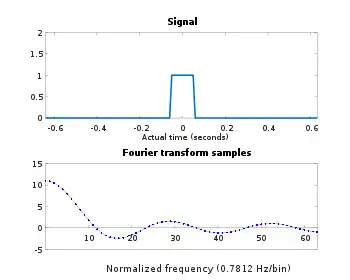Normalized frequency (signal processing)
In digital signal processing (DSP), a normalized frequency is a ratio of a variable frequency (f) and a constant frequency associated with a system (such as a sampling rate, fs). Some software applications require normalized inputs and produce normalized outputs, which can be re-scaled to physical units when necessary. Mathematical derivations are usually done in normalized units, relevant to a wide range of applications.
Examples of normalization
A typical choice of characteristic frequency is the sampling rate (fs) that is used to create the digital signal from a continuous one. The normalized quantity, f′ = f / fs, has the unit cycle per sample regardless of whether the original signal is a function of time or distance. For example, when f is expressed in Hz (cycles per second), fs is expressed in samples per second.[1]
Some programs (such as MATLAB toolboxes) that design filters with real-valued coefficients prefer the Nyquist frequency (fs/2) as the frequency reference, which changes the numeric range that represents frequencies of interest from [0, 1/2] cycle/sample to [0, 1] half-cycle/sample. Therefore, the normalized frequency unit is obviously important when converting normalized results into physical units.

A common practice is to sample the frequency spectrum of the sampled data at frequency intervals of fs/N, for some arbitrary integer N (see § Sampling the DTFT). The samples (sometimes called frequency bins) are numbered consecutively, corresponding to a frequency normalization by fs/N.[2]: p.56 eq.(16) The normalized Nyquist frequency is N/2 with the unit 1/Nth cycle/sample.
Angular frequency, denoted by ω and with the unit radians per second, can be similarly normalized. When ω is normalized with reference to the sampling rate as ω′ = ω / fs, the normalized Nyquist angular frequency is π radians/sample.
The following table shows examples of normalized frequency for f = 1 kHz, fs = 44100 samples/second (often denoted by 44.1 kHz), and 4 normalization conventions:
| Quantity | Numeric range | Calculation | Reverse |
|---|---|---|---|
| f′ = f / fs | [0, 1/2] cycle/sample | 1000 / 44100 = 0.02268 | f = f′ × fs |
| f′ = f / (fs/2) | [0, 1] half-cycle/sample | 1000 / 22050 = 0.04535 | f = f′ × fs / 2 |
| f′ = f / (fs/N) | [0, N/2] bins | 1000 × N / 44100 = 0.02268 N | f = f′ × fs / N |
| ω′ = ω / fs | [0, π] radians/sample | 1000 × 2π / 44100 = 0.14250 | ω = ω′ × fs |
See also
References
- Carlson, Gordon E. (1992). Signal and Linear System Analysis. Boston, MA: ©Houghton Mifflin Co. pp. 469, 490. ISBN 8170232384.
- Harris, Fredric J. (Jan 1978). "On the use of Windows for Harmonic Analysis with the Discrete Fourier Transform" (PDF). Proceedings of the IEEE. 66 (1): 51–83. Bibcode:1978IEEEP..66...51H. CiteSeerX 10.1.1.649.9880. doi:10.1109/PROC.1978.10837. S2CID 426548.